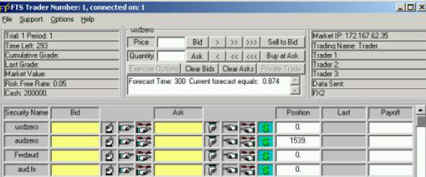Trading Case
FX2
Case Objective
To understand no arbitrage relationships among
exchange rates (spot and forward) and interest rates (domestic and foreign) in
the presence of privately informed traders.
This case is identical to FX1 except that private information is
added. A description of FX1 is repeated
below for convenience.
Key Concepts
Market efficiency; no arbitrage relationships,
covered interest rate parity, spot and forward exchange rates.
In this trading case you will manage a mixed currency
position containing both $USD and $AUD.
There are four markets open that you can submit market and or limit
orders to during the first trading day of a calendar year. At the end of this day time “flashes by” and
your position is marked to market in $USD.
Both short sales and borrowing in either currency is permitted and at
the end of the year your position earns/pays any accrued interest resulting
from your day 1 trading activities.
Markets
Market 1 is “usdzero.” This market trades a zero coupon bond that pays $USD100 at the end of the year. Market 2 is a zero coupon bond, “audzero,” that pays at year end $AUD100. Market 3 is forward exchange rate market, “fwdaud,” that trades $AUD per 1 unit. That is, a limit order of 0.60/1 if hit implies that at the end of the year the bidder pays $USD0.6 to receive $AUD1. If the realized end of year exchange rate is 0.75 then the bidder pays $USD0.6 and receives $AUD1 which has a marked value of $USD0.75 per unit. As a result, the realized gain from this forward exchange rate transaction for 1 contract equals $USD0.15. If 10,000 units had been traded at this price the realized gain equals USD$1,500. Finally, Market 4 (aud.fx) is a spot exchange rate market. It is quoted in units of $USD per 1 $AUD. That is, a bid of 0.60/1 is a limit order that is offering to pay $USD0.60 for $AUD1. Traders can trade up to 10,000 dollars at a time (a click of the mouse).
Interest Rates
You can borrow or lend directly to the money market
at a rate of interest equal to 0.05 per annum.
You can also borrow or lend to the spot $AUD market (“aud.fx”) at the
rate of 0.06 per annum. The set of
possible realizations for the end of year cost of $AUD in units of $USD depends
upon the path each economy follows throughout the year. In this case the possible paths can be ranked
from a weak $AUD to a strong $AUD ranging between: {0.53, 0.80} and each path
is equally likely. It is your task as
part of the trading crowd to discover a price for the spot exchange for the
first day's trading.
Private Information
You will receive unbiased forecasts of the end of
year cost of $AUD in units of $USD throughout the trading day. That is, the information will be in the form
of the “true end of period value” plus or minus some error. The expected value of the error is zero but
the realized error can be positive or negative.
Different trader types get different unbiased forecasts so that in
aggregate the market as a whole always has better information than any
individual forecast. In addition,
information is such that you receive forecasts with smaller errors as
the period progresses.
In the information text box (a single click on the
first security, usdzero, reveals the information in the information text box)
you may observe the following:
Forecast Time: 257 Current analyst forecast 0.650
This means that the forecast became available when
the trading clock was 257-seconds and reveals that an unbiased estimate of the
exchange rate is 0.65.
Forecast Error = (x – 0.5)*y(time), where x is a
random number between (0,1) and y(time) is a scaling variable that starts at
0.5 for the first message and reduces as 0.5, 0.4, 0.3, 0.2, 0.1, 0.09, 0.08,
0.07, 0.06, 0.05 if 10 updates were provided.
So the first error is quite large and equals: realized value +/- up to 0.25.
An example of a screen with information is provided
below.
Trading Objective
Your aim is to make as much money as you can which
depends upon how well you trade relative to the prices discovered by the
market. Each trial you earn
grade cash that is cumulated across trials.
Grade case in any trial equals 0.0001 x your closing balance of market
cash. That is, if you end up with
negative wealth then you lose grade cash and if you make money then you gain
grade cash.
Trading is conducted over a number of independent
trials and a record of your cumulative grade cash is maintained.
